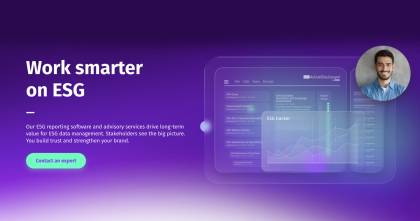Emerging growth companies and established businesses are vying for investor attention and learning a vital lesson—the criteria for capturing the attention of the investment community have changed. Today, it's not just about dollars and cents. It's also about the business's environmental, social, and governance (ESG) messages.
If you're a skeptic who doubts just how much the investor community values ESG, consider this statistic from the U.S. Forum for Sustainable & Responsible Investment (USSIF), "In early 2020, $16.6 trillion in US professionally managed assets employed some form of ESG screening." That figure was up more than 40 percent from 2019. This underscores the importance of ESG reporting in today's environment.
This growth naturally waned a bit during the early days of COVID. That's when the business world shifted into a survival mode mentality. But as we slowly return to normal, it's clear the pandemic has ignited impassioned demands from investors that portfolio companies increase and expand their reporting. A global reporting initiative for ESG should continue to be near the top of your priorities, given how important it is for deal-making and investors.
The focus on ESG is an essential development for the industry but, in its clamor for more reporting, investors failed to provide guidance. This includes where to begin, what matters most, and what types of information they should disclose on their website, and in the proxy, 10-K, and other channels.
In this void, are groups of perplexed companies staring at ratings, rankings, and frameworks with little to no clarity on where to start. Help is coming. This year Sustainability Accounting Standards (SASB) merged with the Integrated Reporting Foundation creating The Value Foundation. Recently at COP26 in Glasgow, the premier global climate summit, International Accounting Standards Board (IASB) announced the formation of the International Sustainability Standards Board (ISSB). This body will merge The Value Foundation and the CDP and will be responsible for developing global sustainability disclosure standards for capital markets. The ISSB will build on existing work carried out by the Climate-Related Financial Disclosures (TCFD) Working Group, which has developed voluntary recommendations regarding relevant disclosures that have been adopted by many companies and have also served basic to improving the mandatory disclosure requirements in the UK.
I'm confident that when solidified, these ESG reporting standards will provide the guidance businesses seek. Still, it will take time, which companies don't have with an investment community that demands action now. To get ahead in this ESG journey, start by following these key steps:
- Focus on Your Material Indicators: As I mentioned above, there are multiple sets of frameworks available, and while they are each different, they overlap somewhat. We recommend focusing primarily on SASB reporting frameworks as well as GRI and TCFD and seeing where these connections exist. Next, determine five to seven material indicators relevant to your industry group and for which you have information to disclose, such as climate, labor, human capital, social inequality, sustainability issues, and so on.
- Examine Peer Disclosures: Check on your industry peers and specifically their disclosures, including proxy, 10-K/AR, website. These are an excellent resource for uncovering important topics to your industry that may not have been identified in step 1. From there, assess what actions the business needs to take to match or exceed the peer accomplishments.
- Create Your Thematic Principles: Between the material indicators and peer-related research, the team should have identified anywhere from seven to 10 topics. Eventually, these will be the foundation of your disclosures. First, have your communications team turn these into three to five thematic principles. For many, these are what I like to call "three Ps tenets," -- our people, purpose, and planet.
- Develop Your ESG Content: Now, it's time to build content around these principles that meet the criteria discussed earlier. Bring in ESG consultants, analysts, and writers to help, and have them work collaboratively on these pieces.
- Think Visually: I'm a big believer in marketing visuals, so as a last step, I recommend turning this ESG content into infographics that mirror or are complementary to company branding.
After completing these steps, we shift to the topic of disclosure and, more specifically, what you should disclose and where.
Web Site
For many, the logical and easiest starting point is your Web site. Here you can post all of the company's existing policies, such as data privacy, workplace health and safety, equal opportunity, anti-harassment/ discrimination, and code of conduct, in as much depth as you like. You can also include this information in the business's Investor Relations section.
Proxy Statement Highlights
For some companies, disclosure may start with the proxy, where businesses may share critical highlights that could impact influential ratings and rankings. Some areas to feature include:
- Board Oversight: If your business has a committee in charge of board oversight, list them here along with their competencies and qualifications. In addition, you may want to report on the diversity of the board itself. One thing to keep in mind is that investors often look for multiple views, such as a breakdown of ethnic and racial diversity and another focused on gender.
- ESG and Human Capital Program Overview: The proxy should include the same programs and policies from the Web site, but just the top highlights, including potential risks, opportunities and priorities, and performance in these areas.
- Executive Compensation: Any ESG-related compensation metrics should be highlighted, such as health and safety, employee development, and diversity initiatives.
- COVID Impact Statements: Here, focus on your COVID-related efforts such as employee health and safety, remote work, and efforts to maintain productivity and morale.
Annual Report/10-K
Integrated reporting that features financial reporting and a company's operations and non-financial data isn't as prevalent in the US as in other countries, but this should not preclude you from including these details if you want. This information will always have an audience with investors who are looking for additional factors when making decisions.
Regardless of what you do, keep an eye on the SEC's calls for a principles-based approach to human capital disclosures. Part of SEC rule S-K modernization, these could eventually call for companies to include human capital resources and any human capital measures or objectives (that are a focus of managing the business) in their 10-K or other fillings. Examples here include the number and types of employees with a specific breakdown into areas such as full-time, part-time, seasonal, and temporary workers.
The Corporate Social Responsibility (CSR) Report
These reports represent the best opportunity to showcase the company's complete CSR story. Be sure to include details on programs and how they are impacting the environment and community. This is not a one size fits all approach either. Businesses can choose which format suits them best. For one, it may be a short six-page SASB fact sheet, while for others, it could be a 20+ page Summary Sustainability Report.
The Sustainability or ESG Report
These reports present the best opportunity to showcase the company's sustainability story and long term value creation. Be sure to include details on programs and how they are impacting the environment and community. This is not a one size fits all approach either. Businesses can choose which format suits them best. For one, it may be a short six-page SASB fact sheet, while for others, it could be a 20+ page Summary Sustainability Report.
There is good reason to be encouraged about the creation of universal ESG reporting standards. These will likely include the guidance that businesses require. But companies should not wait until standards are formalized. With the insights provided here, you can begin your ESG journey today.

